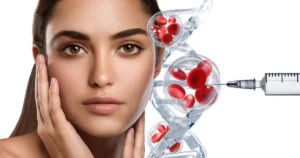Dermal fillers are treatments that help plump up the lips, cheeks, and hollows beneath the eyes while also improving facial features and smoothing out wrinkles. Hyaluronic acid, a naturally occurring component in the skin that keeps it supple and young, is typically found in these products. Depending on the kind of filler and the treated location, dermal filler effects can last anywhere from six months to two years.
Dermal fillers are usually considered safe and effective; nevertheless, to achieve the greatest results and reduce the chance of problems, appropriate post-treatment care is required. Since the fillers are settling into place in the days after your treatment, it is crucial to pay special attention to these days. If you want to ensure that your fillers look and stay as long as possible, you should avoid certain activities and take the necessary measures.
Avoid Touching or Massaging the Treated Area
One of the most important things to avoid after getting dermal fillers is touching or massaging the treated area and feeling curious about how your skin feels after the procedure is natural. Still, resisting the urge to touch, press, or rub the treated areas is essential.
Touching the area can introduce bacteria, increasing the risk of infection. Massaging or pressing on the fillers can cause them to shift out of place, leading to uneven results. If you feel any lumps or bumps, resist the temptation to massage them yourself—these will often settle on their own, or your practitioner can address them during a follow-up appointment if needed.
Avoid Strenuous Exercise
Exercise is important for overall health, but avoiding strenuous activities for at least 24 to 48 hours after getting dermal fillers is best. High-intensity workouts can increase your heart rate and blood pressure, which can cause swelling and bruising in the treated area.
In the days following your treatment, opt for light activities like walking or gentle stretching. Avoid exercises involving significant bouncing or jarring movements, as these could disturb the fillers before they fully settle. Once you’ve given your body time to adjust, you can gradually return to your regular exercise routine.
Avoid Excessive Heat Exposure
After receiving dermal fillers, avoiding exposing your skin to excessive heat is crucial. This includes avoiding saunas, hot tubs, steam rooms, and hot showers or baths. Heat can cause your blood vessels to dilate, which may increase swelling and bruising around the injection sites.
Additionally, excessive heat can break down the hyaluronic acid in the fillers more quickly, reducing their longevity. If you need to be in a warm environment, keep the treated areas cool with cold compresses or ice packs (wrapped in a cloth to avoid direct contact with the skin) for short periods to minimize swelling.
Avoid Alcohol and Blood-Thinning Medications
Alcohol and blood-thinning medications can increase the likelihood of bruising and swelling after dermal filler treatments. It is best to abstain from alcohol for at least 24 hours before and following your procedure since it might dilate your blood vessels, making your bruises and swelling more noticeable.
Similarly, over-the-counter pain relievers like aspirin and ibuprofen, as well as certain supplements such as fish oil and vitamin E, can thin the blood and should be avoided for a few days after treatment. If you’re taking prescription blood thinners, be sure to consult your healthcare provider before your dermal filler appointment.
Avoid Sleeping on Your Face
How you sleep can also affect the results of your dermal filler treatment. It’s important to avoid sleeping on your face for at least the first few nights after your procedure. Pressure on the treated areas can cause the fillers to shift or become misshapen, leading to uneven results.
Instead, try to sleep on your back with your head elevated. Using an extra pillow can help reduce swelling by encouraging fluid drainage. If you’re a habitual stomach or side sleeper, it might be helpful to use pillows to create a barrier that keeps you in a supine position throughout the night.
Avoid Intense Sun Exposure
Sun protection is always important for maintaining healthy skin, but it’s especially critical after getting dermal fillers. Exposure to UV light increases inflammation and the possibility of problems following treatment, such as hyperpigmentation or early filler breakdown.
To protect your skin:
- Avoid direct sunlight for at least a week following your treatment.
- When venturing outdoors, don a broad-brimmed hat and slather on an SPF-30 or more broad-spectrum sunscreen.
- Reapply sunscreen every two hours and more frequently if you’re sweating or swimming.
Even on cloudy days, UV rays can penetrate your skin, so diligent sun protection is key.
Avoid Heavy Makeup and Skin Treatments
In the first 24 to 48 hours after your dermal filler treatment, avoiding applying heavy makeup, especially to the treated areas, is best. Makeup can irritate injection sites or introduce microorganisms that could cause an infection, and our skin will be more sensitive than usual.
In addition to makeup, avoid facial treatments such as chemical peels, microdermabrasion, or laser therapies for at least two weeks. These procedures may be dangerous for your skin during the filler-induced healing phase, which might compromise the procedure’s efficacy.
Avoid Smoking
Smoking is bad for the general health of your skin and can ruin the effects of a dermal filler procedure. Cigarette smoke contains compounds that can narrow blood vessels, decreasing blood flow to the treated regions and impeding healing. Additionally, smoking might shorten the duration and efficiency of fillers by speeding up the breakdown of hyaluronic acid in them.
If you smoke, consider this an excellent opportunity to quit, not only to preserve the results of your dermal fillers but also to improve your overall health and skin appearance.
Monitor for Unusual Symptoms
While dermal fillers are generally safe, it is important to monitor your skin for any unusual symptoms after your treatment. Mild swelling, redness, and bruising are normal and should subside within a few days. But if you suffer from excruciating pain, persistent swelling, or infection symptoms like increasing redness, warmth, or pus, call a medical professional right away.
These symptoms could indicate a rare but serious complication that requires prompt medical attention. If something doesn’t seem right, it’s always better to err on the side of caution and seek professional advice.
Achieve Your Best Look with Ocean State Laser & Aesthetics
Dermal fillers can offer fantastic results when done correctly and followed with proper care. By avoiding these common pitfalls and following your provider’s post-treatment instructions, you can ensure that your fillers look natural, last longer, and help you achieve the rejuvenated appearance you desire.
If you’re considering dermal fillers or have recently undergone dermal filler treatments in East Greenwich, RI, Ocean State Laser & Aesthetics is here to help you with every step. Our team of experienced professionals is dedicated to providing personalized care and ensuring you achieve the best possible results from your treatment.
Contact Ocean State Laser & Aesthetics today and learn more about how we can help you achieve your beauty goals. Your journey to a more confident and youthful appearance starts here!




